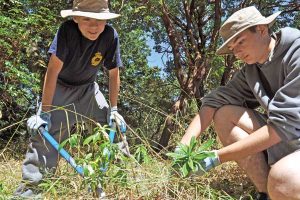Air cadets wage war against invasive species
By Lookout on Jul 29, 2013 with Comments 0

Cadet Clayton Leone and Cadet Kyle Baird, both from Ladysmith, work together to remove the daphne laurel at Fort Rodd Hill and Fisgard Lighthouse National Historical Site. Cadet Leone is on the three-week Basic Drill and Ceremonial Course, graduating July 26, and Cadet Baird is on the six-week Ceremonial Instructor Course, graduating Aug. 16.
More than 120 air cadets spent the day toiling in the sun, all for the betterment of one of our local treasures – Fort Rodd Hill and Fisgard Lighthouse National Site.
As one of the largest groups to volunteer their time and muscles, the cadets helped remove invasive plants that threaten the Garry oak ecosystem, did a bit of gardening and built a sandbag wall on July 19.
“It was wonderful to have so many dedicated and well organized cadets help us with the Garry Oak ecosystem work we do here at Fort Rodd Hill and Fisgard Lighthouse National Historic Site,” said Susan MacIsaac, Species at Risk Communications Officer with Parks Canada. “It would have taken my staff of three a month to do what the cadets accomplished in one day.”
After the teens piled off the three buses, they were split into three groups.
The first group started removing daphne laurel – a particularly invasive plant that grows as high as a metre, choking and shading out other plants that the Garry oak ecosystem needs to thrive and remain healthy. This activity was certainly more than just weeding – requiring gloves and pruning shears.
The second group went to the nursery, and working side by side with their flight-mates, helped thin out camas bulb beds. Cadets carefully sorted through moist earth looking for camas bulbs, an indigenous plant that grows only in Garry oak ecosystems. Once they found the bulbs, they were set aside for planting.
Yet another group spent the morning helping build one of two sandbag walls at the entrance to Fort Rodd Hill. The project involved moving and carefully placing heavy sandbags.
“The wall will stand as a reminder that this is a military historic site, and that young men and women not much older than these cadets were overseas fighting behind structures much like this,” said Bob Campbell, Collections Manager and Historic Weapons Supervisor with Parks Canada.
After their day of work, the cadets got a brief moment to relax, but were surprised by an unscheduled historic weapons demonstration, which included firing of blank rounds. The arsenal includes various rifles (one that looks very similar to what the cadets use for drill), a pistol and, as the grand finale, a BREN light machine gun that fires bursts at nine rounds a second.
After the display, Parks Canada had one final request – to help move all the cut daphne laurel debris into one spot. Lightening quick, 15 cadets volunteered, willing to give their muscles one last workout. The strapping young cadets lifted the large tarp filled with cut daphne laurel, working together to move the heavy load hundreds of metres across uneven terrain – even through a narrow gate.
And then – mostly on time – the day with Fort Rodd Hill and Fisgard Lighthouse National Historic Site was done, and the community service project successfully complete. With tired muscles, a sense of achievement (and a nice red Parks Canada cap for each and every cadet), the cadets climbed their bus for the trip back to Albert Head.
“We had fun,” said Cadet Josh Burneau (386 Squadron in Lazo), a cadet on the six-week Drill and Ceremonial Instructors Course. “Even though the work was hard, we learned how to work as a team, and how fun helping the community really can be.”
The cadets are completing the three-week Basic Drill and Ceremonial Course and six-week Ceremonial Instructor Course at Albert Head Air Cadet Summer Training Centre. Their contribution to Fort Rodd Hill and Fisgard Lighthouse National Historic Site – coincidently in time for Canada’s Parks Day on Saturday July 20 – satisfied program requirements for their community service project.
The development of responsible and caring citizens is one of the most important aspects of the Cadet Program. Cadets participate in citizenship activities in Victoria and other cities and towns across Canada throughout the year.
-Lt(N) Peggy Kulmala, AHACSTC Public Affairs
Filed Under: Top Stories
About the Author:





